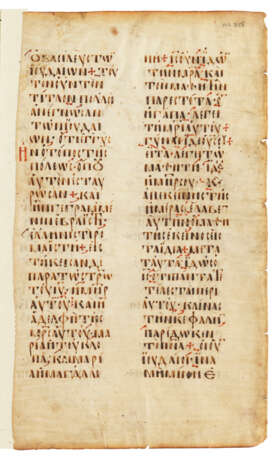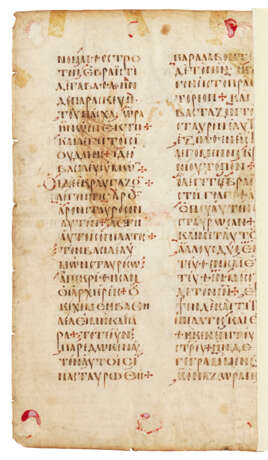ID 1053116
Lot 2 | Byzantine ekphonetic notation
Estimate value
£ 15 000 – 20 000
A leaf from a Gospel Lectionary, in Greek, manuscript on vellum [Byzantine Empire, late 10th century]
A rare survival of one of the earliest, 'preclassic' systems of musical notation.
A single leaf, 330 x 192mm, two columns of 24 lines written in brown ink in a tall late 10th-century Greek majuscule, ruled space: c.250 x 150mm, ekphonetic notation in red and dark brown, 2 initials in red (a few stains, some marginal darkening, a few creases, else in excellent condition). Bound in grey buckram.
Provenance:
(1) Sotheby’s, 22 June 1999, lot 61.
(2) Schøyen Collection, MS 2858.
Text:
The text is from John 19:13-31 (the Crucifixion and a reading for the Friday of the Passion). The manuscript has been as identified as ℓ 2413 in the Gregory-Aland numbering.
Script and music:
The script is a fine example of late 10th-century Greek uncial, and is notable for the marked contrast between thick and thin strokes and the ekphonetic notation in red ink indicating the pauses and changes of pitch used in the chanting of the appointed scriptural pericopes. It is particularly close to a 10th-century Gospel lectionary from Cappadocia or Southern Italy at the British Library, Arundel MS 547.
The term 'ekphonetic' was coined by I. Tzetzes in 1885 (from the Greek 'to call out', or 'declaim'). In no case is the musical significance of the signs known, and hypothetical transcriptions are possible only by comparison with cantillation in the modern practice of the various traditions. Byzantine ekphonetic notation emerged at the beginning of the 9th century and occurred almost exclusively in Old and New Testament lectionaries. It continued to be used until the 14th century, whereupon the system fell into disuse, and the meaning of the notational signs was forgotten. For further reading on the subject, see C. Höeg, La notation ekphonétique, 1935.
| Place of origin: | Greece |
|---|---|
| Auction house category: | Medieval & renaissance manuscripts |
| Place of origin: | Greece |
|---|---|
| Auction house category: | Medieval & renaissance manuscripts |
| Address of auction |
CHRISTIE'S 8 King Street, St. James's SW1Y 6QT London United Kingdom | ||||||
|---|---|---|---|---|---|---|---|
| Preview |
| ||||||
| Phone | +44 (0)20 7839 9060 | ||||||
| Buyer Premium | see on Website | ||||||
| Conditions of purchase | Conditions of purchase |




